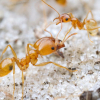- Formiculture.com
- Forums
- Gallery
- Members
- Member Map
- Chat

Help me with my camponotus ants
Started By
Pokee5954
, Jan 22 2023 1:19 AM
16 replies to this topic
#1
 Offline
-
Posted January 22 2023 - 1:19 AM
Offline
-
Posted January 22 2023 - 1:19 AM
I recently got carpenter ants 1 queen and 10 workers and despite all the research there was a few thing that I could not get clear answers on I was not sure how often I should be feeding them protein and sugar water all the answers I saw said different things and also how often should I be checking on them how often is to often
#2
 Offline
-
Posted January 22 2023 - 1:33 AM
Offline
-
Posted January 22 2023 - 1:33 AM
You can really check on them whenever and as many times as you want. I've found that ants are more sensitive to vibrations than they are to light.
For sugar water, you want to give them as much as they can drink within maybe like 30 minutes to an hour and then remove it unless you have a liquid feeder, then just leave it in there for a week or 2 before washing it out and replacing it. As for the proteins, just give them as much as they can eat and take it out when they move it to a trash location. You can feed them more as soon as you see their old food in the trash or once a week to once every other week. It's really up to how quickly you want your colony to grow.
- KadinB likes this
#3
 Offline
-
Posted January 22 2023 - 7:39 AM
Offline
-
Posted January 22 2023 - 7:39 AM
Sugar water in a feeder (assuming it doesn't dry out) last for about 4-7 days, depending on room temperature, before it goes bad.
For protein there isn't really a hard value, just feed them something - if they take all give more, if they don't take it give less.
Fruit flies and tiny roaches are good becaue they enable you to see what your ants actually take. If you give them something huge (like a superworm or an adult Dubia roach) they will drink from it (or remove a small piece) and you'll have no idea how much they actually took.
Over time you will get a feeling for how much they eat.
Generally they will take protein when they have larvae and ignore it when there's none (eggs and pupae don't eat), so especially for Camponotus ants that tend to lay eggs in batches protein intake can vary wildly, depending on what brood stages they have in the nest.
For looking at them, i'd keep it to once or twice a week - Camponotus queens like to eat their eggs when they feel disturbed, although since you have workers it's probably not that big of an issue.
Generally ants prefer to be left alone, for them opening the nest usually means something bad is about to happen.
Edited by Serafine, January 22 2023 - 7:46 AM.
We should respect all forms of consciousness. The body is just a vessel, a mere hull.
Welcome to Lazy Tube - My Camponotus Journal
#4
 Offline
-
Posted January 22 2023 - 7:51 AM
Offline
-
Posted January 22 2023 - 7:51 AM
Have sugar water available at all times via a liquid feeder. Feed protein twice a week or so with a colony that size. You can feed more protein depending on your budget and how fast you want the colony to grow.
"The ants are a people not strong, yet they prepare their meat in the summer." Prov. 30:25
Keep ordinary ants in extraordinary ways.
Keep ordinary ants in extraordinary ways.
#5
 Offline
-
Posted January 22 2023 - 9:15 AM
Offline
-
Posted January 22 2023 - 9:15 AM
My carpenter ants could probably eat sugar every day but eat protien more sparsely.
Pretty much what antdrew said.
Pretty much what antdrew said.
Edited by LowQualityAnts, January 22 2023 - 9:16 AM.
#6
 Offline
-
Posted January 22 2023 - 10:01 PM
Offline
-
Posted January 22 2023 - 10:01 PM
Congratulations for becoming a Camponotus keeper! To feed sugar and water to my small Camponotus colonies I just use a couple of small cotton balls (about 1 cm around) in a tray (the pull tab from a cream container) and saturate one with sugar water and one with fresh water. I make them different shapes so I know which is which when they look dry and it comes time to refresh them. They have water and sugar water available at all times.
For protein I feed mine mostly meat. Cooked chicken and turkey liver are a favourite as well as cooked chicken and turkey meat. The trick I find is to take the best bit of meat you can get, I use the oyster muscle from the back of the chicken for example, freeze it, and then I use a scalpel to shave very thin slices, across the grain of the meat, like you would carve any fine roast. When the slices are thawed it is crumbly and the ants can pick it up and easily carry it back to the nest. This technique also works well for raw pork, cooked pork, fish and scrambled eggs, all of which are eaten by my colonies. I also feed them insects like crickets, mealworms, earwigs, flies, beetles, wasps, and hornets. Typically, for a ten-worker colony of mine I would feed only a cut up part of any of these insects to a fast-growing colony each day,
The queen and larvae are the only ants that require protein. How much protein a colony needs will depend primarily on how many larvae there are and how much they are eating. By covering the nest area of the colony with red cellophane it is possible to observe your Camponotus ants without disturbing them. I check out the number of larvae and their size and I can usually also spot a food cache in the nest that they are working on. They normally nest in trees and can get quite used to vibration.
I generally feed mine an amount of food that they can clean up in four hours. It's hard to say exactly because a colony with only ten workers will probably only send out two or three foragers at a time. You can learn a lot about the condition of a colony by watching them at feeding time. My ants usually prowl around the feeding area if they need food and they come running to see what I've brought them. I remove any uneaten food when it looks like they're losing interest. I try to feed mine on a three-day cycle. I feed them for two days and remove the feeder on the third day. This fasting day ensures that they use up any stored food in the nest and gives me a chance to wash their feeders and prepare them for the next day.
My Camponotus usually lay their eggs in batches, so I often notice a sudden drop in their interest in protein when the larvae pupate and don't eat any more. I can confirm that by checking the brood. Observing your colonies when you feed them, and observing the condition of the brood, is a good way to monitor their progress and assess their future need for food, water or space.
My father always said I had ants in my pants.
#7
 Offline
-
Posted January 23 2023 - 7:09 AM
Offline
-
Posted January 23 2023 - 7:09 AM
No matter what I give my Camponotus Vicinus they won’t eat, but their liquid feeder seems to be emptying, but it could just be evaporating.
#8
 Offline
-
Posted January 23 2023 - 6:46 PM
Offline
-
Posted January 23 2023 - 6:46 PM
No matter what I give my Camponotus Vicinus they won’t eat, but their liquid feeder seems to be emptying, but it could just be evaporating.
All of mine are hibernating, (diapause), right now. They don't eat anything during that time.
My father always said I had ants in my pants.
#9
 Offline
-
Posted January 23 2023 - 7:25 PM
Offline
-
Posted January 23 2023 - 7:25 PM
I saw you had asked a question in chat, but left before it got a response. This is Pokee5945's question: "I had a question hopefully someone in here can help me I’ve been having alot of trouble feeding my ant colony in the test tube I don’t want them getting out and stuff but I don't want to move them to a nest to early what should I do?"
If you feel like it's becoming too much for you to feed them in the test tube, you could consider upgrading to a small formicarium. Doing so wouldn't harm them. It would definitely be more manageable than a test tube.
#10
 Offline
-
Posted January 24 2023 - 8:09 AM
Offline
-
Posted January 24 2023 - 8:09 AM
No matter what I give my Camponotus Vicinus they won’t eat, but their liquid feeder seems to be emptying, but it could just be evaporating.
All of mine are hibernating, (diapause), right now. They don't eat anything during that time.
Mine is low-elevation Camponotus Vicinus so they don’t hibernate, but slow down a little in winter.
#11
 Offline
-
Posted January 24 2023 - 8:34 AM
Offline
-
Posted January 24 2023 - 8:34 AM
What size/instar are your colonies larvea?
- CAantz likes this
#12
 Offline
-
Posted January 24 2023 - 12:09 PM
Offline
-
Posted January 24 2023 - 12:09 PM
What size/instar are your colonies larvea?
Sorry for asking questions on someone else’s thread, but the larvae are small around 2-3 instar and there are 3 of them.
#13
 Offline
-
Posted January 24 2023 - 12:53 PM
Offline
-
Posted January 24 2023 - 12:53 PM
My camponotus americanus have a few batches of small larvae and they eat less often but eat more food when they are hungry. What do you feed them as this could also effect how much/if they eat.
#14
 Offline
-
Posted January 24 2023 - 1:15 PM
Offline
-
Posted January 24 2023 - 1:15 PM
I have offered them bloodworm soup, fish flakes, crickets, and hummingbird nectar. I have only seem them take a few small sips of the nectar. I have ordered mealworms and they will come either tomorrow or the next day.
#15
 Offline
-
Posted January 24 2023 - 1:35 PM
Offline
-
Posted January 24 2023 - 1:35 PM
If mealworms don't work you could try cricket legs or termites caught from wet cardboard traps.
#16
 Offline
-
Posted January 24 2023 - 1:36 PM
Offline
-
Posted January 24 2023 - 1:36 PM
Thanks!
#17
 Offline
-
Posted January 24 2023 - 7:04 PM
Offline
-
Posted January 24 2023 - 7:04 PM
Try offering them cooked chicken liver or meat as I mentioned above, shaved thinly when frozen, so it is crumbly when it thaws out. If my ants are hungry, they never fail to accept these foods, especially the liver.
My father always said I had ants in my pants.
0 user(s) are reading this topic
0 members, 0 guests, 0 anonymous users



















